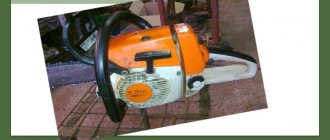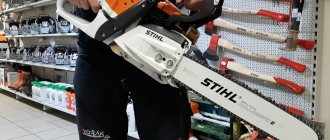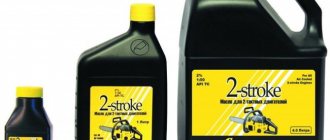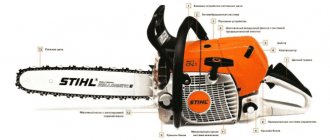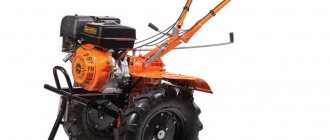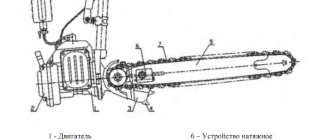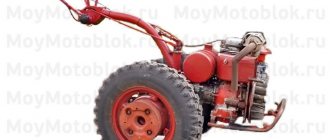Are chainsaw tires interchangeable or not? For example: will a tire from Husqvarna fit a Shtil of the same size?
No. Tires differ significantly in their shanks. There is the shape, width of the groove, the presence and location of the lubrication hole, the location of the hole for the tensioner pin. I'm not even talking about the pitch and number of chain links. _____________________________________
Is it possible to convert a Partner 351 chainsaw from a 3/8 1.3 chain to a 325 1.5?
The drive sprocket with the clutch cup is taken from a Husqvarna 137-142 chainsaw, but you need to look for a tire. And it will be difficult for the Partner to work with such a chain.
On the Interskol PTs-16/2000TN saw I use chains one link less than what was included in the kit, with the same bar length (16″), that is, not 57 links, but 56.
I don’t experience any particular inconvenience, but it’s a little more difficult to put on such a shortened chain. But there is less need to tighten the toolless chain tensioning drum when tensioning it. _____________________________________
Is it harmful to use a shortened chain on a chainsaw for the bar and drive sprocket?
No, it's not harmful. The sprocket is torn off by a stretched chain, because the chain and sprocket do not match in pitch. And because there are fewer links on the new chain, the pitch does not change. _____________________________________
The enemy of sprockets and tires is stretched chains. How much should a chain stretch to be considered unusable?
It is not clear how changing stretched chains preserves the sprocket and tire. If we change the stretched one to normal, then everything is clear. And if it’s also stretched, then what changes?
For a chainsaw, purchase a set of chains. As practice shows, when replacing a sprocket and tire, the optimal number of new chains is 4 m.
This will allow you to wear the sprocket, tire and chains evenly. And you need to throw out the chain when it reaches the threshold, when the tensioner is no longer enough.
It is necessary to change the chains not every 3-4 refuelings, but at every 2nd refueling or earlier, depending on the sharpness of the chain. And do not forget to turn the tire over, and also monitor the appearance of a burr on the tire.
As a rule, it appears after the 4th used chain from the set. That is, 4 chains have become blunt, take a flat file and remove the burr with a light movement. _____________________________________
What sprocket is needed for the Oregon 200SLHD009 20 3/8 1.3mm tire? That is, its article number or catalog number, otherwise sellers cannot always fully explain the instrument. Possible chain options for this tire. From the best (I suspect Stihl) to the cheapest?
On different models, it is very likely that the drive sprockets will be different. If the drive sprocket is ring-shaped (crown), then it’s a little easier. Ring sprockets with a large mounting hole are the same for all manufacturers.
With a small mounting hole (the English word “small” is usually indicated after the name) there are two types - the first, Shtilevsky, used on saws made by them, and the second, used on saws from other manufacturers, although some models may also have a Shtilevsky crown.
All three types of ring sprockets are not interchangeable. To choose the right type correctly, you need the name of the saw model.
A chain for a chainsaw is definitely needed with the same parameters as the tire. That is, 3/8″ x 1.3 mm. The shape of the cutting tooth is preferably with a rounded transition of the tooth blade to the lateral cutting edge.
This type of chain according to the Oregon classification is “chipper”, according to the Shtilev classification - “micro”, suddenly you will be lucky and get “standard” chains according to the Shtilev classification, with them this rounding is even more clearly visible, although the chains of the latter type are either discontinued or are produced in very limited editions.
Chainsaw chains classified as “chisel” or “super” (according to Stihl) are not very suitable for longitudinal sawing. When used this way, they will quickly become dull, and increasing the vibration level will not add to the life of the saw.
The number of links in the chain is indicated on the tire itself. If the tire is “native”, from the saw’s factory configuration, then these two numbers – those indicated on the tire and those required – actually coincide.
If the tire was originally intended to be used by a different model, then the actual chain length may be one link more or less than indicated. _____________________________________
I found analogues of tires from a Champion chainsaw. All parameters are suitable and the shank is suitable. only his sprocket is not lubricated by Stihl’s proprietary lubrication system.
It is necessary to periodically fill the grease with a syringe through a special hole. Has anyone come across this?
So, on any tire the driven sprocket is not lubricated by the lubrication system. There are only two options for bearings - maintenance-free closed ones installed on Shtilevsky tires, the supply of lubricant inside them is designed for the entire service life of the tire under average operating conditions, and bearings on tires from other manufacturers; lubricant must be added to such bearings regularly.
For example, I lubricate the driven sprocket once a day before starting work when sawing wood or similar work, and when sawing with the end of a bar - every time I add chain oil, since in this case the load on the bearing is higher. _____________________________________
Let's assume that there are two tires, one 30cm. And the second one is 40cm. The chains differ only in the length of the log with a diameter of 20 cm. Will there be a significant difference in the load on the chainsaw engine?
When the saw is operating without load, i.e. in the absence of contact with wood, the resistance of the chain to its rotation set by the engine will be proportional to the number of links.
But it is insignificant compared to the resistance of the wood that appears when the circuit comes into contact with it. So there will be a difference in the load, but it can only be measured with instruments. _____________________________________
Tell me, is the chainsaw bar fastener universal? In the sense that (purely technically) you can install any tire on a chainsaw?
I’m now thinking about consumables for my CC3045, and if with chains it’s clear that you need to select according to the tire, then what to do with the tire itself? How can we select an alternative? As far as I understand, the pitch cannot be changed, because the chainsaw’s drive sprocket is tailored to it.
The length can be changed - the main thing is that the engine can withstand (the working surface when increasing the length and increased speed when working on a shorter tire). Is it possible to change the groove width? or does the drive sprocket also impose restrictions?
The main criterion, which is universal for all chainsaws and all types of tires, is the presence of lubrication holes in the right places on the shank of the tire. For tires without a built-in tensioner, the location of the hole for tensioning the chain is important.
For some small saws, there may be a limitation on the width of the bar; with some wide tires, it is possible for the chain to catch on the clutch cover as it comes out from under it.
If the tire does not have a driven sprocket, for example like the Shtilevsky Duromatic, then the chain pitch is not important. Otherwise, the pitch of the driven sprocket must coincide with the pitch of the driving sprocket and, naturally, with the pitch of the chain itself.
If you plan to regularly work with the same saw, but with chains with different shank thicknesses, then it is better to have its own drive sprocket for each thickness, so that there is no accelerated wear of the chain shanks, and then its stretching, as when installing a new chain on an old, worn one , asterisk.
For episodic, or rather one-time, work, the asterisk does not need to be changed. When changing the chains used to a chain with a different shank thickness “permanently”, the sprocket will need to be changed. ______________________________________________________________________________
The total thickness (or width) of the links in the place where they slide along the tire of the Shtilevskaya chain is 0.5 mm greater than that of the Oregon chain. Will this only affect the wear pattern of the tire?
For a tire, such an increase in the thickness of the connecting links has no significance. Theoretically, it is possible that there may be some reduction in productivity when sawing along the entire length of the bar, especially when cutting longitudinally, due to faster clogging of the gap between the teeth with sawdust, but in practice this is most likely not to be noticed. _____________________________________
I once heard that the tire is changed at the same time as the sprocket on the chainsaw. Is this really true?
There is no template or sample for this, it changes as it wears out. For example, I have 3-4 drive sprockets per tire. _____________________________________
When switching from a full-profile chain to a low-profile one, with a 1.3 shank, do you also need to change the tire to a special one, or is there just one tire for everything?
The tire groove must correspond to the thickness of the drive link, so change it. The use of thin chains on 1.5 or 1.6 tires is only possible theoretically.
In practice, we have poor-quality cuts and very rapid wear of both the chain and the track on the tire. And the shape of the tire sprocket teeth is somewhat different. _____________________________________
There is a need to use the thinnest chain and bar on a chainsaw. You need a chain and a bar for the most accurate and thin cut, and, if possible, with a clean, even cut. Is it possible to install such a bar and chain without consequences for the saw? If so, which ones are better to take?
Try “live” to try on the Oregon tires on your saw that come with the younger Kubkadet CC2740 model, these are 160SDEA095 and 160SPEA095. If the oil hole and the hole for the tensioner fit, then you can start selecting the chain.
As I have already said many times, its length does not necessarily have to correspond to the number on the shank of the tire. In this case, since with increasing power the linear dimensions of the saw have also increased, there is a very high probability that you will need a chain one link longer than that indicated on the bar.
Since such a reduction in the cutting width will significantly reduce the load on the engine, you will have to not squeeze the gas to capacity, but limit yourself to approximately 2/3-3/4 of the throttle lever stroke. There is another option, a little more dangerous to use.
Change the crown of the drive sprocket to another with a larger number of teeth. You will have to select again experimentally, but there is nothing complicated here. There are only 3 mounting sizes of crowns.
A standard one (the name/article ends in STD) and two small ones (Shtilevsky and for other saws), their article number ends in SM (apparently an abbreviation for “small”). Increasing the number of teeth on the crown will increase the load on the engine; perhaps this increase will compensate for the decrease in load from the use of thinner bars and chains.
The increased danger during operation is due to the fact that the linear speed of the chain will become higher. In addition, a ring with a large number of teeth also has a larger outer diameter, so the chain will probably have to be lengthened by one more link.
When using any of these options or both of them in combination, the number of revolutions under load should be controlled; for a long time it should not be significantly higher than what the saw develops under load when using a standard saw set.
Source benzpila.ru
— from 300 rub. Free for orders over 15,000 rubles.
The Oregon 59AC064E saw chain is suitable for chainsaws: Ural, Ural 2, Ural 2T Electron, Ural 70, Ural 76, Druzhba 5E, Druzhba 4M Electron, Druzhba 2, STIHL MS 880, Parma (Inkar).
The 59L Super Guard chain is designed for professionals, designed for sawing large logs with powerful chain saws. Works especially well on hard wood and in difficult taiga conditions.
- Chisel cutting links with rectangular side edges provide maximum productivity.
- Wedge-shaped cutting depth limiters reduce saw kickback.
- Lubrilink links help keep oil where it is needed in the chain.
- The index line on the top edge simplifies precision sharpening.
Recommended for saws with engine displacement up to 65 cm3 and above with guide bars 20” (50 cm) or more in length.
Sharpened using a standard 7/32” (5.5 mm) round file.
Similar chains: Stihl 46RM 36680061480; MI-10.26 U-16 Strong
Source realforest.ru
Household, semi-professional and professional hand-held chainsaw equipment, regardless of cost and performance characteristics, has an identical design. The cutting set, which includes a chainsaw bar and saw chain, belongs to the category of replacement equipment.
The decision on which tire to put on a chainsaw is made by the owner, taking into account many factors. First of all, this is the compatibility of the seat and the channels for supplying lubricant to the working area, engine power, and the specifics of the work to be done.
Specific assistance in choosing a tire independently can be provided by recommendations from experienced specialists or information from the instructions for use.
In particular, a long saw set is preferable for felling and sawing large-diameter trees, while a short saw set is preferable for crowning trees and preparing for the installation of construction timber.
Tire from "Druzhba"
A long time ago, one good person claimed that a very good steel for a knife is the bar from the Druzhba chainsaw.
Is this really true? And then I got this material. What is there now, probably no one will say. Perhaps just structural steel like Steel 40-45. Possibly a carbon instrumental like U7-U8. Perhaps a spring 65G or something similar. In general, you can try to make a knife, but you will have to do some technical work and you shouldn’t expect anything supernatural.

